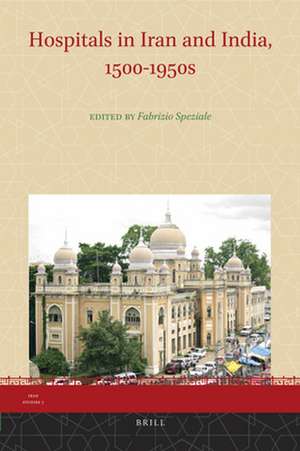Hospitals in Iran and India, 1500-1950s: Iran Studies, cartea 7
Editat de Fabrizio Spezialeen Limba Engleză Hardback – 18 apr 2012
Contributors include: Cristiana Bastos, Willem Floor, Claudia Preckel, Omid Rezai, Fabrizio Speziale, Hasan Tadjbakhsh, Anna Vanzan
This book is copublished with the Institut Français de Recherche en Iran (IFRI) as no. 74 in the Bibliothéque Iranienne series.
Le présent ouvrage propose un panorama significatif d’études portant sur l’histoire et le rôle des hôpitaux dans le monde irano-indien au cours de la première modernité et de l’époque moderne. Les contributions rassemblées dans ce volume étudient l’hôpital depuis plusieurs perspectives, examinant cet établissement tantôt comme une institution scientifique, tantôt en fonction de son utilité sociale. Ce qui émerge de ces travaux ne constitue pas un portrait homogène, mais plutôt une image ambivalente et contrastée de ces établissements. Les hôpitaux peuvent être vus comme des symboles puissants de la piété des souverains musulmans, ou de la civilisation scientifique musulmane, puis du triomphe de la science occidentale moderne. Cependant, pour une très longue période, l’hôpital demeure une institution reléguée à la marge de la société, regardée avec suspicion et en particulier réservée aux indigents.
Ce livre est une coédition avec l’Institut Français de Recherche en Iran (IFRI) comme n◦ 74 dans la série Bibliothèque Iranienne
Din seria Iran Studies
- 18%
 Preț: 761.64 lei
Preț: 761.64 lei - 18%
 Preț: 630.51 lei
Preț: 630.51 lei - 18%
 Preț: 588.90 lei
Preț: 588.90 lei - 37%
 Preț: 627.07 lei
Preț: 627.07 lei - 18%
 Preț: 1032.27 lei
Preț: 1032.27 lei - 18%
 Preț: 512.06 lei
Preț: 512.06 lei - 18%
 Preț: 678.63 lei
Preț: 678.63 lei - 18%
 Preț: 672.32 lei
Preț: 672.32 lei - 18%
 Preț: 541.45 lei
Preț: 541.45 lei - 18%
 Preț: 576.44 lei
Preț: 576.44 lei - 18%
 Preț: 622.32 lei
Preț: 622.32 lei - 18%
 Preț: 649.93 lei
Preț: 649.93 lei - 18%
 Preț: 560.98 lei
Preț: 560.98 lei - 18%
 Preț: 684.38 lei
Preț: 684.38 lei - 15%
 Preț: 522.81 lei
Preț: 522.81 lei - 18%
 Preț: 654.91 lei
Preț: 654.91 lei - 15%
 Preț: 520.86 lei
Preț: 520.86 lei - 18%
 Preț: 1367.38 lei
Preț: 1367.38 lei - 18%
 Preț: 942.46 lei
Preț: 942.46 lei - 18%
 Preț: 843.52 lei
Preț: 843.52 lei - 18%
 Preț: 813.07 lei
Preț: 813.07 lei - 18%
 Preț: 976.57 lei
Preț: 976.57 lei
Preț: 636.16 lei
Preț vechi: 775.80 lei
-18% Nou
Puncte Express: 954
Preț estimativ în valută:
121.73€ • 127.42$ • 101.32£
121.73€ • 127.42$ • 101.32£
Carte indisponibilă temporar
Doresc să fiu notificat când acest titlu va fi disponibil:
Se trimite...
Preluare comenzi: 021 569.72.76
Specificații
ISBN-13: 9789004228290
ISBN-10: 9004228292
Pagini: 244
Dimensiuni: 155 x 235 x 20 mm
Greutate: 0.52 kg
Editura: Brill
Colecția Brill
Seria Iran Studies
ISBN-10: 9004228292
Pagini: 244
Dimensiuni: 155 x 235 x 20 mm
Greutate: 0.52 kg
Editura: Brill
Colecția Brill
Seria Iran Studies
Cuprins
Introduction, Fabrizio Speziale
Hôpitaux et médecins avicenniens en Iran à l’époque safavide, Hasan Tadjbakhsh
Hospitals in Safavid and Qajar Iran: An Enquiry into Their Number, Growth and Importance, Willem Floor
Des particuliers au service du peuple. Le rôle des vaqf dans la fondation d’hôpitaux en Iran au début du XXe siècle, Omid Rezai
Together and Apart: Catholic Hospitals in Plural Goa, Cristiana Bastos
Tradition et réforme du dār al-šifā au Deccan, Fabrizio Speziale
Healing the People and the Princes: Hospitals, Ḥakīms and Doctors in Bhopal, Claudia Preckel
Hamdard, How to Share Pain in a Muslim Way, Anna Vanzan
Hôpitaux et médecins avicenniens en Iran à l’époque safavide, Hasan Tadjbakhsh
Hospitals in Safavid and Qajar Iran: An Enquiry into Their Number, Growth and Importance, Willem Floor
Des particuliers au service du peuple. Le rôle des vaqf dans la fondation d’hôpitaux en Iran au début du XXe siècle, Omid Rezai
Together and Apart: Catholic Hospitals in Plural Goa, Cristiana Bastos
Tradition et réforme du dār al-šifā au Deccan, Fabrizio Speziale
Healing the People and the Princes: Hospitals, Ḥakīms and Doctors in Bhopal, Claudia Preckel
Hamdard, How to Share Pain in a Muslim Way, Anna Vanzan
Notă biografică
Fabrizio Speziale, Ph.D. (2002), holds a CNRS Chair in Iranian studies at the University Sorbonne Nouvelle – Paris 3. He has published extensively on the history of medicine in the Indo-Persianate world including Soufisme, religion et médecine en Islam indien (Paris, 2010).
Recenzii
“This volume is the first of its kind and a welcome addition to the scholarship. […] It provides a platform for a very respected publication, in the form of a Brill volume, to internationally less known scholars who also work on this important field for Islamic and Asian medicines. The volume also facilitates the access of international scholars to articles that otherwise would have been published in different journals (maybe far less accessible).” - Miri Shefer-Mossensohn, in: Iranian Studies 48:4, 641-643 [DOI: 10.1080/00210862.2015.1044729]
